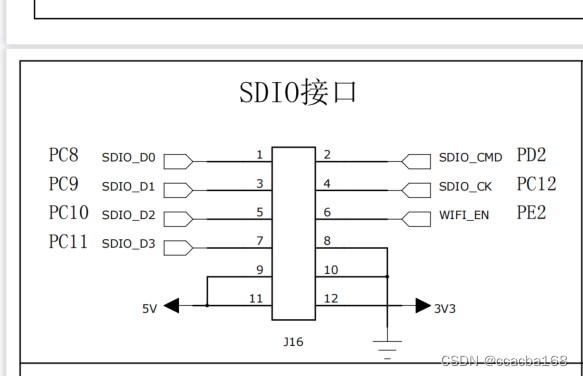目录
前言
SDIO接口是最常用数据通信接口之一,使用在WiFi,U盘、sdcard等
移植调试过程:
一、查看原理图确认所使用的的GPIO口

GPIO基本是固定的,clk由控制器输出,cmd为指令控制,data为读写数据使用
二、上电初始化
1.配置GPIO
void SD_LowLevel_Init(void)
{
GPIO_InitTypeDef GPIO_InitStructure;
/* GPIOC and GPIOD Periph clock enable */
RCC_AHB1PeriphClockCmd(RCC_AHB1Periph_GPIOC | RCC_AHB1Periph_GPIOD, ENABLE);
GPIO_PinAFConfig(GPIOC, GPIO_PinSource8, GPIO_AF_SDIO);
GPIO_PinAFConfig(GPIOC, GPIO_PinSource9, GPIO_AF_SDIO);
GPIO_PinAFConfig(GPIOC, GPIO_PinSource10, GPIO_AF_SDIO);
GPIO_PinAFConfig(GPIOC, GPIO_PinSource11, GPIO_AF_SDIO);
GPIO_PinAFConfig(GPIOC, GPIO_PinSource12, GPIO_AF_SDIO);
GPIO_PinAFConfig(GPIOD, GPIO_PinSource2, GPIO_AF_SDIO);
/* Configure PC.08, PC.09, PC.10, PC.11 pins: D0, D1, D2, D3 pins */
GPIO_InitStructure.GPIO_Pin = GPIO_Pin_8 | GPIO_Pin_9 | GPIO_Pin_10 | GPIO_Pin_11;
GPIO_InitStructure.GPIO_Speed = GPIO_Speed_50MHz;
GPIO_InitStructure.GPIO_Mode = GPIO_Mode_AF;
GPIO_InitStructure.GPIO_OType = GPIO_OType_PP;
GPIO_InitStructure.GPIO_PuPd = GPIO_PuPd_UP;
GPIO_Init(GPIOC, &GPIO_InitStructure);
/* Configure PD.02 CMD line */
GPIO_InitStructure.GPIO_Pin = GPIO_Pin_2;
GPIO_Init(GPIOD, &GPIO_InitStructure);
/* Configure PC.12 pin: CLK pin */
GPIO_InitStructure.GPIO_Pin = GPIO_Pin_12;
GPIO_InitStructure.GPIO_PuPd = GPIO_PuPd_NOPULL;
GPIO_Init(GPIOC, &GPIO_InitStructure);
/* Enable the SDIO APB2 Clock */
RCC_APB2PeriphClockCmd(RCC_APB2Periph_SDIO, ENABLE);
/* Enable the DMA2 Clock */
RCC_AHB1PeriphClockCmd(SD_SDIO_DMA_CLK, ENABLE);
}2.给SDcard上电
/**
* @brief Enquires cards about their operating voltage and configures
* clock controls.
* @param None
* @retval SD_Error: SD Card Error code.
*/
SD_Error SD_PowerON(void)
{
__IO SD_Error errorstatus = SD_OK;
uint32_t response = 0, count = 0, validvoltage = 0;
uint32_t SDType = SD_STD_CAPACITY;
/*!< Power ON Sequence -----------------------------------------------------*/
/*!< Configure the SDIO peripheral */
/*!< SDIO_CK = SDIOCLK / (SDIO_INIT_CLK_DIV + 2) */
/*!< on STM32F4xx devices, SDIOCLK is fixed to 48MHz */
/*!< SDIO_CK for initialization should not exceed 400 KHz */
SDIO_InitStructure.SDIO_ClockDiv = SDIO_INIT_CLK_DIV;
SDIO_InitStructure.SDIO_ClockEdge = SDIO_ClockEdge_Rising;
SDIO_InitStructure.SDIO_ClockBypass = SDIO_ClockBypass_Disable;
SDIO_InitStructure.SDIO_ClockPowerSave = SDIO_ClockPowerSave_Disable;
SDIO_InitStructure.SDIO_BusWide = SDIO_BusWide_1b;
SDIO_InitStructure.SDIO_HardwareFlowControl = SDIO_HardwareFlowControl_Disable;
SDIO_Init(&SDIO_InitStructure);
/*!< Set Power State to ON */
SDIO_SetPowerState(SDIO_PowerState_ON);
/*!< Enable SDIO Clock */
SDIO_ClockCmd(ENABLE);
/*!< CMD0: GO_IDLE_STATE ---------------------------------------------------*/
/*!< No CMD response required */
SDIO_CmdInitStructure.SDIO_Argument = 0x0;
SDIO_CmdInitStructure.SDIO_CmdIndex = SD_CMD_GO_IDLE_STATE;
SDIO_CmdInitStructure.SDIO_Response = SDIO_Response_No;
SDIO_CmdInitStructure.SDIO_Wait = SDIO_Wait_No;
SDIO_CmdInitStructure.SDIO_CPSM = SDIO_CPSM_Enable;
SDIO_SendCommand(&SDIO_CmdInitStructure);
errorstatus = CmdError();
if (errorstatus != SD_OK)
{
/*!< CMD Response TimeOut (wait for CMDSENT flag) */
return(errorstatus);
}
/*!< CMD8: SEND_IF_COND ----------------------------------------------------*/
/*!< Send CMD8 to verify SD card interface operating condition */
/*!< Argument: - [31:12]: Reserved (shall be set to '0')
- [11:8]: Supply Voltage (VHS) 0x1 (Range: 2.7-3.6 V)
- [7:0]: Check Pattern (recommended 0xAA) */
/*!< CMD Response: R7 */
SDIO_CmdInitStructure.SDIO_Argument = SD_CHECK_PATTERN;
SDIO_CmdInitStructure.SDIO_CmdIndex = SDIO_SEND_IF_COND;
SDIO_CmdInitStructure.SDIO_Response = SDIO_Response_Short;
SDIO_CmdInitStructure.SDIO_Wait = SDIO_Wait_No;
SDIO_CmdInitStructure.SDIO_CPSM = SDIO_CPSM_Enable;
SDIO_SendCommand(&SDIO_CmdInitStructure);
errorstatus = CmdResp7Error();
if (errorstatus == SD_OK)
{
CardType = SDIO_STD_CAPACITY_SD_CARD_V2_0; /*!< SD Card 2.0 */
SDType = SD_HIGH_CAPACITY;
}
else
{
/*!< CMD55 */
SDIO_CmdInitStructure.SDIO_Argument = 0x00;
SDIO_CmdInitStructure.SDIO_CmdIndex = SD_CMD_APP_CMD;
SDIO_CmdInitStructure.SDIO_Response = SDIO_Response_Short;
SDIO_CmdInitStructure.SDIO_Wait = SDIO_Wait_No;
SDIO_CmdIni




 该文详细介绍了在STM32平台上使用SDIO接口对SD卡进行移植和调试的过程,包括查看GPIO配置、上电初始化、SD卡电源管理、初始化流程、时钟配置、数据宽度设置以及读写数据接口的实现。在调试过程中遇到的问题,如数据线信号异常和命令响应错误,也给出了相应的解决方案。
该文详细介绍了在STM32平台上使用SDIO接口对SD卡进行移植和调试的过程,包括查看GPIO配置、上电初始化、SD卡电源管理、初始化流程、时钟配置、数据宽度设置以及读写数据接口的实现。在调试过程中遇到的问题,如数据线信号异常和命令响应错误,也给出了相应的解决方案。
 最低0.47元/天 解锁文章
最低0.47元/天 解锁文章


















 550
550

 被折叠的 条评论
为什么被折叠?
被折叠的 条评论
为什么被折叠?










